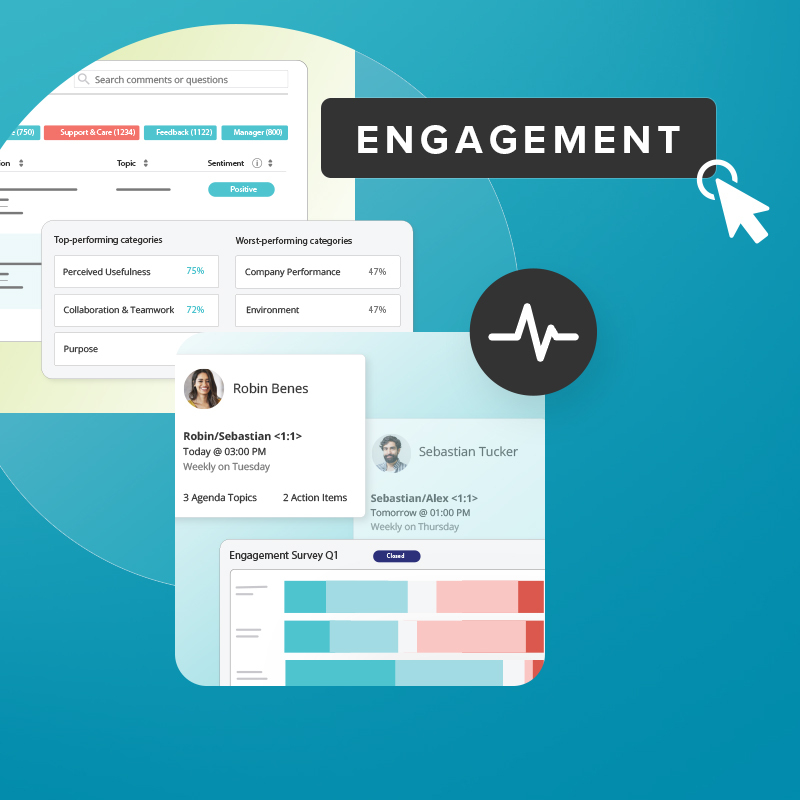Pause your day for a moment and take a look around your workplace. The faces seem to get younger by the day, don’t they? Good or bad, welcomed or unwelcomed, Betterworks Engage is here to tell you that trend won’t be stopping anytime soon. In fact, as the few remaining Baby Boomers in the workforce segue into retirement and replaced by Gen X and millennials, the roughly 61 million members of Gen Z are just now becoming a significant segment of nearly every organization’s team.
Like every generation before it, Gen Z has particular characteristics, goals, and expectations that make it unique amongst other employee segments. Also like other generations, those particulars mean employers must take the time to understand what motivates Gen Z to maximize their engagement with the organization and maximize productivity.
Therefore, Betterworks Engage is providing you with eight simple tips for improving Gen Z employee engagement. When coupled with the extraordinary insights revealed by Betterworks Engage’s feedback solutions, you’ll have both the understanding and people analytics necessary to fully engage your Gen Z employee segment.
Getting to Know Gen Z
Before we get to the eight tips, we thought a brief description of Gen Z was in order to lend context to our best practices. First, remember there’s no definitive measure of what constitutes Gen Z as definitions and age ranges vary. However, generally speaking, Gen Z encompasses people born between 1995 and 2012. This particular age range means Gen Z tends to be extremely comfortable with technology, born and raised within the digital age.
Aside from that comfort with technology, a handful of traits are also prevalent across the majority of the demographic. While no two individuals are exactly alike, employers are likely to find these common characteristics within the Gen Z population:
- Entrepreneurial spirit: Much of the creative, independent mentality pervasive throughout Gen Z stems from a combination of the financial crisis from 2008 and the startup culture so ubiquitous throughout the 21st century. The results are a distinct entrepreneurial spirit that shapes most, if not all of their decisions and places less emphasis on traditional career trajectories and more on carving their own path in life.
- Balanced lives: Likewise, given that independent mentality, Gen Z tends to place great importance in a seamless blend of work and life. A preference for freedom in choices has replaced the stable desk jobs preferred by older generations. This notion makes remote working especially attractive to Gen Z as it gives them options that a typical 9-to-5 job simply doesn’t offer.
- Diversity: By 2020, over 50% of American children will belong to a minority group. In the EU, immigrants have accounted for 70% of employment growth over the last decade. Therefore, diversity is an expectation of Gen Z, not a goal or ideal. They spend their everyday lives interacting with people of different cultural groups and orientations so, suffice it to say, an employer must be open to a highly diverse workforce to fully engage their Gen Z employee segment.
As you’ll see, these characteristics inform the best practices so crucial in fully engaging your Gen Z workforce. Betterworks Engage is in no way suggesting you immediately veer from your current management strategies to cater towards the forthcoming wave of Gen Z employees, but consider these eight tips as you form policies and procedures to evolve in lockstep with a tremendously diverse and dynamic labor market.
1. Incorporate Gen Z Values
Your initial impression of Gen Z employees might cause you to pause for a moment, particularly when it comes to learning and development. Remember, a unique blend of frugality, equality, and creativity drives Gen Z which, collectively, often lead to questions you might be unaccustomed to fielding during training sessions.
Where older generations might have been perfectly comfortable sitting through your training and development programs, diligently taking notes and doing their best to absorb the material, Gen Z is likely to begin each session by asking why it’s necessary in the first place. Although this might be off-putting at first glance, it’s merely a product of the core values that define the generation and their decision-making.
Incorporate a more global perspective when training your Gen Z employee segment, explaining each session’s goals and how it feeds into your organization’s overall mission, values, and vision for the future. Likewise, draw parallels between each employee’s particular position within the enterprise and how it fits into the bigger picture.
Thankfully, when you provide sound reasoning behind your policies and procedures, whether that entails training sessions, career advancement, or office rules of conduct, Gen Z employees are likely to fully embrace them and actively strive for excellence.
2. Strive for Authenticity
A fully engaged Gen Z employee is one that embraces your organization’s mission and culture, not hesitating to readily identify with it and strive to reach personal and organizational goals. Given their innately independent spirit, there are indeed hurdles to overcome to get to that position but, once accomplished, a Gen Z employee is far more likely to immerse themselves in your corporate vision.
An overarching authenticity that pervades every decision you make as an organization plays a significant role in helping you overcome those hurdles and engage with your Gen Z employee base. Anything perceived as a fabrication or product of market research and best guesses is likely to be questioned and viewed from a skeptical eye. Instead, be real and relatable in everything you do, not fabricated for mass consumption but motivated by sincerity.
3. Be Adaptable
Driven by their natural comfort with technology, organizations must be adaptable to change to engage Gen Z, particularly concerning innovation in thought and practice. Granted, this concept might be easily adopted by some but a significant obstacle for others depending on an enterprise’s openness to technology. However, whether openly embraced or integrated with sizable amounts of trepidation, being a vanguard towards innovative change is an essential requirement for engaging with younger generations.
To decide what technologies to pursue — no easy feat considering the pace technology evolves — most organizations are wise to establish a cross-departmental committee that stays abreast of industry-specific innovations. Within this committee, appoint individuals from each department to study technology that might positively impact their team, bringing their findings to the rest of the group for further discussion.
Depending on availability, Gen Z employees can make excellent additions to such committees due to their perspective on technology. Be judicious and meticulous with your investments of time and money, however, and don’t pursue change simply for change’s sake. Seek out sources of improved efficiency and effectiveness to add value to your operations and maintain a perpetually innovative mindset.
4. Provide Innovative Tools
Just as adopting technology on an organization-wide basis is critical for a sense of adaptability, so is providing innovative tools for individual roles and responsibilities for your Gen Z workforce. In fact, the average Gen Z worker is accustomed to switching between five devices for different purposes. Therefore, multitasking between desktops, mobile devices, and other tools is obviously second nature for your younger workers and, conveniently, their preferred way to seek and absorb information as well. Embrace this notion by providing them similar tools within their roles, allowing them to fully utilize their absolute comfort with technology to their benefit as well as yours.
5. Foster a Collaborative Environment
Both the physical and digital lives of Gen Z are incredibly interactive. For example, creative social media is an entirely intuitive and pervasive way for younger generations to communicate. When such a need and comfort with interactivity is combined with an innate desire to succeed and prosper, engaging Gen Z requires a collaborative environment that favors teamwork and camaraderie. Organizations that can foster cooperation and a sense of community within the workplace will draw the best from Gen Z, revealing their innovative spirit and commitment to excel when properly motivated.
6. Reward an Entrepreneurial Perspective
According to recent research, over 75% of Gen Z consider themselves entrepreneurial in spirit, and nearly 50% would like to start their own company at some point. Such attitudes are a far cry from older generations, many of which placed a high value on low risk, stable, and predictable careers. To engage Gen Z’s comparatively different perspective, employers should employ similarly different tactics.
Make younger generations stakeholders in your enterprise, both within their individual roles as well as actual ownership or performance-based profit sharing. Treat Gen Z employees as if they’re the owners of a small business within the larger organizational umbrella. Use KPIs commonly associated with smaller enterprises to gauge individual performance, rewarding success with some sort of profit sharing or, if not feasible, then bonus structures anchored to performance metrics.
7. Think Global, Act Local
60% of Gen Z want their jobs and organizations to positively impact the world. In other words, employers must think bigger picture and how they can bring about positive change, even if it’s just in a small, localized way. Naturally, such a notion can’t come at the expense of productivity and profitability but, from a messaging perspective, placing additional focus on positive global change rather than strictly emphasizing growth and the bottom line fosters significant engagement with Gen Z staff.
Organize events that help the community, start food drives, or even adopt specific charities for enterprise-wide initiatives. Incorporate such movements into your culture and mission, making them a part of your strategic plan. Such actions aren’t entirely altruistic, of course, as the increased engagement from your employee base will positively impact productivity and enhance the employee experience.
8. Provide Continuous Feedback
Gen Z doesn’t want to work in a vacuum. As discussed, they thrive in an interactive, collaborative atmosphere that fosters teamwork, community, and frequent feedback on their performance. This dynamic extends to their relationships with managers, where they want consistent input from their supervisors and, just as importantly, delivered in a convenient and unobtrusive manner.
The antiquated notion of feedback based on annual reviews and infrequent conversations with management isn’t sufficient to properly engage your Gen Z employees. They’re already accustomed to providing instantaneous feedback on everything else in their lives through review sites, social media, and other channels. However, most organizations have inadequate, if any, feedback systems in place, essentially forcing employees to wait for their review to provide a thorough feedback forum.
Fortunately, employers aren’t on their own when searching for effective feedback solutions that combine insights with convenience, precise people data with seamless integration into existing communication platforms.
Betterworks Engage’s sole focus is on providing employers the feedback solutions needed to harness, analyze, and take action on the wealth of information already sitting in front of them. With a potent combination of technology-driven pulse polls, surveys, and other tools, Betterworks Engage gives organizations the real-time data necessary to engage their Gen Z employees through the channels they already prefer.
Guessing games won’t suffice to engage any segment of your workforce, much less one like Gen Z with particular expectations and a willingness to question your decision making. Trust in the expertise of a true partner like Betterworks Engage and adopt insightful feedback tools to best prepare your organization. The bulk of the Gen Z wave has yet to even hit the shoreline but is already making permanent changes in the ways an employer must engage its workforce.




